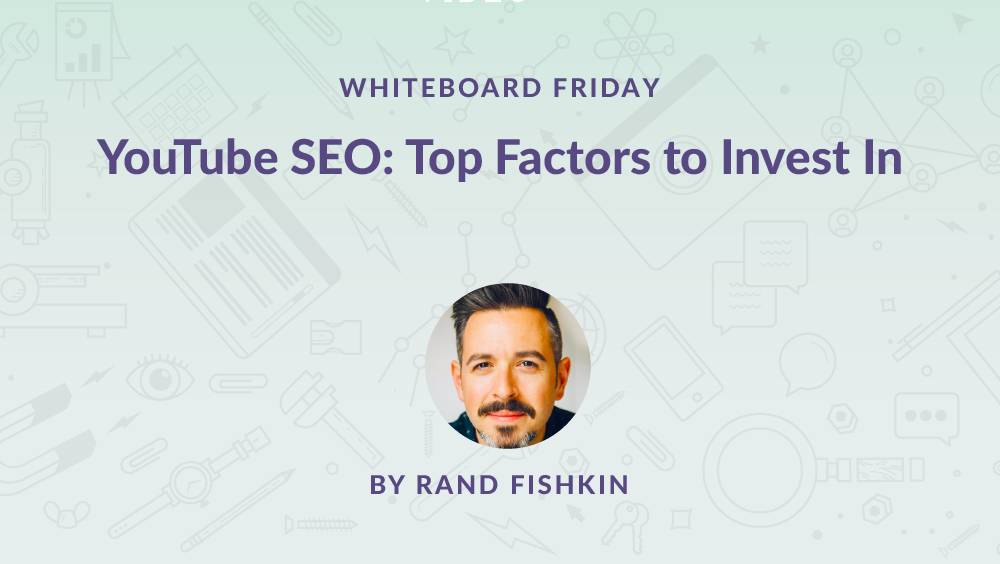Inspired by a large-scale study from Justin Briggs, Rand covers the top factors to invest in when it comes to YouTube SEO in this week's episode of Whiteboard Friday. So I was lucky enough to be speaking at the Search Love Conference down in San Diego a little while ago, and Justin Briggs was there presenting on YouTube SEO and on a very large-scale study that he had conducted with I think it was 100,000 different video rankings across YouTube's search engine as well as looking at the performance of many thousands of channels and individual videos in YouTube. So YouTube will let you apply keyword tags to a video. This is something that used to exist in Google SEO decades ago with the meta keywords tag. So using keyword tags in two to three word phrase elements and usually the videos that Justin's dataset saw performing best were those with 31 to 40 unique tags, which is a pretty hefty number. So they're adding a lot of different tags on there, 31 to 40, and those tended to do the best. Certain video lengths perform and rank well Number five, the videos that perform best -- I like that this correlates with how Whiteboard Fridays do well as well -- 10 to 16 minutes in length tend to do best in the rankings. So the study looked at the rankings, higher rankings up here and lower rankings down there, versus embeds. All right, everyone, if you're producing video, which I probably recommend that you do if video is ranking in the SERPs that you care about or if your audience is on YouTube, hopefully this will be helpful, and I urge you to check out Justin's research. We'll see you again next week for another edition of Whiteboard Friday.
If you have an audience on YouTube, are you doing everything you can to reach them? Inspired by a large-scale study from Justin Briggs, Rand covers the top factors to invest in when it comes to YouTube SEO in this week’s episode of Whiteboard Friday.

CC
Off
English
.

Click on the whiteboard image above to open a high-resolution version in a new tab!
Video Transcription
Howdy, Moz fans, and welcome to another edition of Whiteboard Friday. This week we’re chatting about YouTube SEO. So I was lucky enough to be speaking at the Search Love Conference down in San Diego a little while ago, and Justin Briggs was there presenting on YouTube SEO and on a very large-scale study that he had conducted with I think it was 100,000 different video rankings across YouTube’s search engine as well as looking at the performance of many thousands of channels and individual videos in YouTube.
Justin came up with some fascinating results. I’ve called them out here @JustinBriggs on Twitter, and his website is Briggsby.com. You can find this study, including an immense amount of data, there. But I thought I would try and sum up some of the most important points that he brought up and some of the conclusions he came to in his research. I do urge you to check out the full study, especially if you’re doing YouTube SEO.
5 crucial elements for video ranking success
So first off, there are some crucial elements for video ranking success. Now video ranking success, what do we mean by that? We mean if you perform a search query in YouTube for a specific keyword, and not necessarily a branded one, what are the things that will come up? So sort of like the same thing we talk about when we talk about Google success ranking factors, these are success factors for YouTube. That doesn’t necessarily mean that these are the things that will get you the most possible views. In fact, some of them work the other way.
1. Video views and watch time

First off, video views and watch time. So it turns out these are both very well correlated and in Justin’s opinion probably causal with higher rankings. So if you have a video and you’re competing against a competitor’s video and you get more views and a greater amount of watch time on average per view — so that’s how many people make it through a greater proportion of the video itself –you tend to do better than your competitors.
2. Keyword matching the searcher’s query in the title

Number two, keyword matching still more important we think on YouTube than it is in classic Google search. That’s not to say it’s not important in classic Google, but that in YouTube it’s even more important. It’s even a bigger factor. Essentially what Justin’s data showed is that exact match keywords, exactly matching the keyword phrase in the video title tended to outperform partial by a little bit, and partial outperformed none or only some by a considerable portion.
So if you’re trying to rank your video for what pandas eat and your video is called “What Pandas Eat,”that’s going to do much better than, for example, “Panda Consumption Habits” or “Panda Food Choices.” So describe your video, name your video in the same way that searchers are searching, and you can get intel into how searchers are using YouTube.
You can also use the data that comes back from Google keyword searches, especially if videos appear at the top of Google keyword searches, that means there’s probably a lot of demand on YouTube as well.

COMMENTS